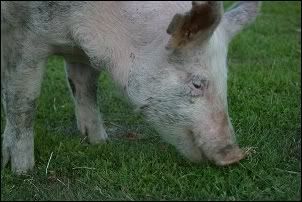The photos are cute: bright-eyed, smiling children embracing doe-eyed, happy animals. Some of the animals even have digitally added gift tags around their necks for that extra special holiday cheer! For $45-500 US dollars, you can put money into a general fund of an organization who may or may not take a perfectly intelligent, emotional animal, ship them thousands of miles by boat to a poor family in a far off land who will raise and slaughter them. Charming.
Here's why not to support animal donation programs like OxFam's, Heifer International's, or MercyCorps'. This is not a complete list, of course.
If you are an animal lover: Farm animals are smart. They are emotional. All can suffer, experience pain and know joy. Why take a nice, happy-go-lucky goat, stick her on a boat for a thousand mile treacherous trip to where she may not be fed properly and will definitely have her throat slit? Besides, it should just really offend your sensibilities when these animals are referred to as "products" and then portrayed as cheerful participants in their own subjugation and death. It should at least creep you out.
If you care about people: Asia and Africa have the highest levels of lactose intolerance, with upwards of 90% being unable to properly digest milk. In Zambia, nearly 100% of the population is lactose intolerant. Yet Heifer International has several dairy cattle projects in Zambia. Sending dairy cows to areas with a mostly lactose intolerant population is mind-boggling, really.
If you like the environment: Farm animals are resource freaks. They drink a lot (one of our pigs will drink 5 gallons a day, one of our cows around 25 gallons). They eat a lot (our two cows could probably munch through a bale of hay a day). Goats especially are known destroyers of land and creators of deserts. Some of these people have enough problems with deserts, they don't need more. Since these recipients are already living on such limited resources, why add another resource-guzzling burden in the form of livestock?
If you like fine print: Read the fine print of these organizations. Your money isn't going to buy an animal. It's going to go in a general fund. While this may be common practice to avoid litigation, it is definitely misleading. If you care about that sort of thing, anyways.
Fine Print: OxFam, Heifer International has two fine print answers (Yes, your money goes into a specific fund, and No, it doesn't -scroll down to the tiny print), MercyCorps (at the bottom in barely readable font color)
Instead of donating an animal to an impoverished family in another country, why not check out these alternatives? These organizations are working to reduce human suffering through programs that are sustainable and animal friendly.
Sustainable Harvest International
Food for Life
Trees for Life
The Fruit Tree Planting Foundation
Women's Bean Project
Change the world
Change.org is a social networking tool aimed at creating change in the world. Every action moving toward the goal of reducing suffering is a positive one.
Support us in working to reduce the pain and misery the billions of farmed animals and all other animals endure at the hands of humans. We are their only hope.
Support us in working to reduce the pain and misery the billions of farmed animals and all other animals endure at the hands of humans. We are their only hope.
This text is replaced by the Flash movie.
Piglet Makeover
Once upon a time there was a freshly groomed piglet named Hazel.
 And then she was not (freshly groomed, that is).
And then she was not (freshly groomed, that is).


Ah, the joys of mud baths (according to Hazel, they are real joyful).
Hazel can now enjoy the simple things, like rooting in the grass and belly rubs. This wasn't always so. A few months ago, she was confiscated as part of a cruelty case because she wasn't being fed. You could see her ribs and hip bones. She had an inner ear infection and mange. She was a mess. We're grateful to have her with us - she brightens our days with her playful antics!
 And then she was not (freshly groomed, that is).
And then she was not (freshly groomed, that is).

Ah, the joys of mud baths (according to Hazel, they are real joyful).
Hazel can now enjoy the simple things, like rooting in the grass and belly rubs. This wasn't always so. A few months ago, she was confiscated as part of a cruelty case because she wasn't being fed. You could see her ribs and hip bones. She had an inner ear infection and mange. She was a mess. We're grateful to have her with us - she brightens our days with her playful antics!
Calendar Contest Winners
Contests are fun, but we always like it when everyone wins. Nearly 40 submissions were entered into our first annual Barnyard Pals calendar contest. We selected three winners and made all other entries available for purchase with no mark-up at our cafepress store.
Here are the first, second and third place winners! Congrats and thanks to everyone who participated.
First Place: Peaches, the handsome sheep.

Second Place: Jena, the adorable bunny

Third Place: Rusty, the pretty hen

Here are the first, second and third place winners! Congrats and thanks to everyone who participated.
First Place: Peaches, the handsome sheep.

Second Place: Jena, the adorable bunny

Third Place: Rusty, the pretty hen

A will to live
Caring for farmed animals has its ups and downs. One of our pigs, Isabelle, is a shining example of both! Isabelle is a "production" pig, bred to gain weight in a short amount of time for slaughter at six months.
Because of their size, when they fall down or injure their back or hips, euthanasia is often the only option. Unlike dogs and cats or smaller farmed animals, we can't just pick up a 700-lb pig and carry her to the vet. When they go down, it's often for good.
Several weeks ago, Isabelle slipped in the mud and injured the muscles and nerves in her lower back. We put up a shelter around her and called the vet. The initial prognosis was not good, the vet suggested we consider euthanasia if she didn't show signs of improvement after a few days.
Sometimes, you just know when an animal is ready. A look, their behavior, or such clear distress the answer is simple. With Isabelle, this wasn't the case - she was alert, eating, drinking, talking to us and the other pigs...she looked like she wanted to live. We called another vet, desperate for another answer.
The vet came out and suggested electro-acupuncture. It was a last resort and if it didn't work, nothing would. We thought, why not? Euthanasia is always a final option. Since Isabelle wasn't suffering, wasn't in pain, and was acting like Isabelle, we gave it a go.
Not much changed after the first treatment. Our hopes were dimming. Isabelle wasn't giving up, though, so we agreed to do one last treatment as a last ditch effort. The vet was kind enough to provide the service for free, knowing it was an unlikely victory.
Two days after the second treatment, Isabelle boosted our hopes by getting up and walking! She walked a good hundred feet to our center pasture full of fresh grass. After a few nibbles, she collapsed from the effort. We again moved shelter to her and arranged for another treatment. By this point, Isabelle was showing signs that she could feel the acupuncture...and get grumpy about it! That she was showing signs of discomfort was good, it meant she had regained some feeling!
Finally, Isabelle was able to walk all the way up to a stall in the barn and there she's remained. She's showing gradual signs of improvement and is tentatively walking around. We don't know if she will fully recover, and we know the final option may still be inevitable. But we aren't giving up hope, because Isabelle has shown us that she has a powerful will to live.
We'll keep you updated.
-Marji Beach, Program Coordinator
Because of their size, when they fall down or injure their back or hips, euthanasia is often the only option. Unlike dogs and cats or smaller farmed animals, we can't just pick up a 700-lb pig and carry her to the vet. When they go down, it's often for good.
Several weeks ago, Isabelle slipped in the mud and injured the muscles and nerves in her lower back. We put up a shelter around her and called the vet. The initial prognosis was not good, the vet suggested we consider euthanasia if she didn't show signs of improvement after a few days.
Sometimes, you just know when an animal is ready. A look, their behavior, or such clear distress the answer is simple. With Isabelle, this wasn't the case - she was alert, eating, drinking, talking to us and the other pigs...she looked like she wanted to live. We called another vet, desperate for another answer.
The vet came out and suggested electro-acupuncture. It was a last resort and if it didn't work, nothing would. We thought, why not? Euthanasia is always a final option. Since Isabelle wasn't suffering, wasn't in pain, and was acting like Isabelle, we gave it a go.
Not much changed after the first treatment. Our hopes were dimming. Isabelle wasn't giving up, though, so we agreed to do one last treatment as a last ditch effort. The vet was kind enough to provide the service for free, knowing it was an unlikely victory.
Two days after the second treatment, Isabelle boosted our hopes by getting up and walking! She walked a good hundred feet to our center pasture full of fresh grass. After a few nibbles, she collapsed from the effort. We again moved shelter to her and arranged for another treatment. By this point, Isabelle was showing signs that she could feel the acupuncture...and get grumpy about it! That she was showing signs of discomfort was good, it meant she had regained some feeling!
Finally, Isabelle was able to walk all the way up to a stall in the barn and there she's remained. She's showing gradual signs of improvement and is tentatively walking around. We don't know if she will fully recover, and we know the final option may still be inevitable. But we aren't giving up hope, because Isabelle has shown us that she has a powerful will to live.
We'll keep you updated.
-Marji Beach, Program Coordinator





